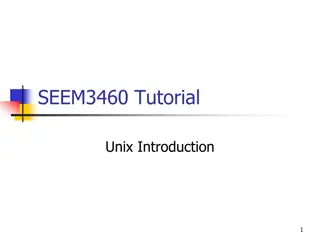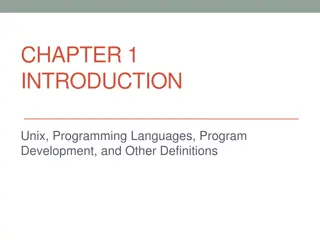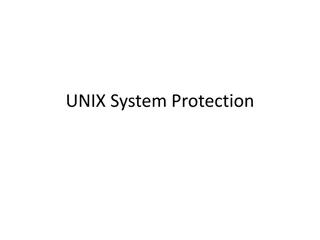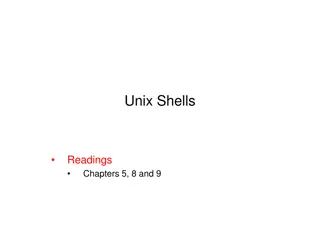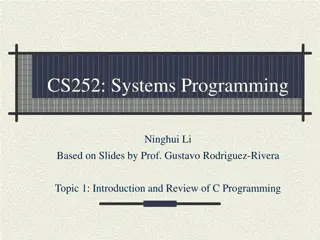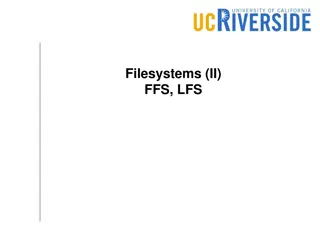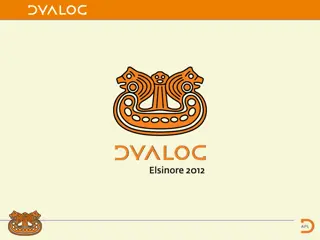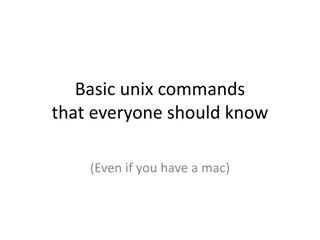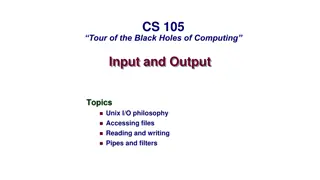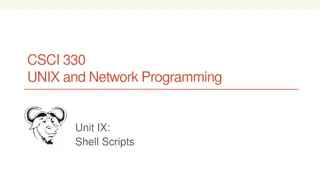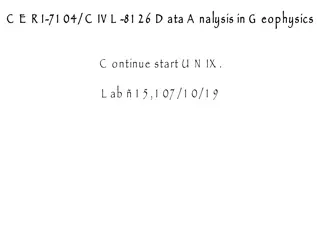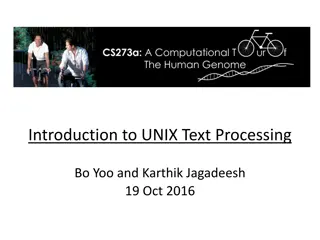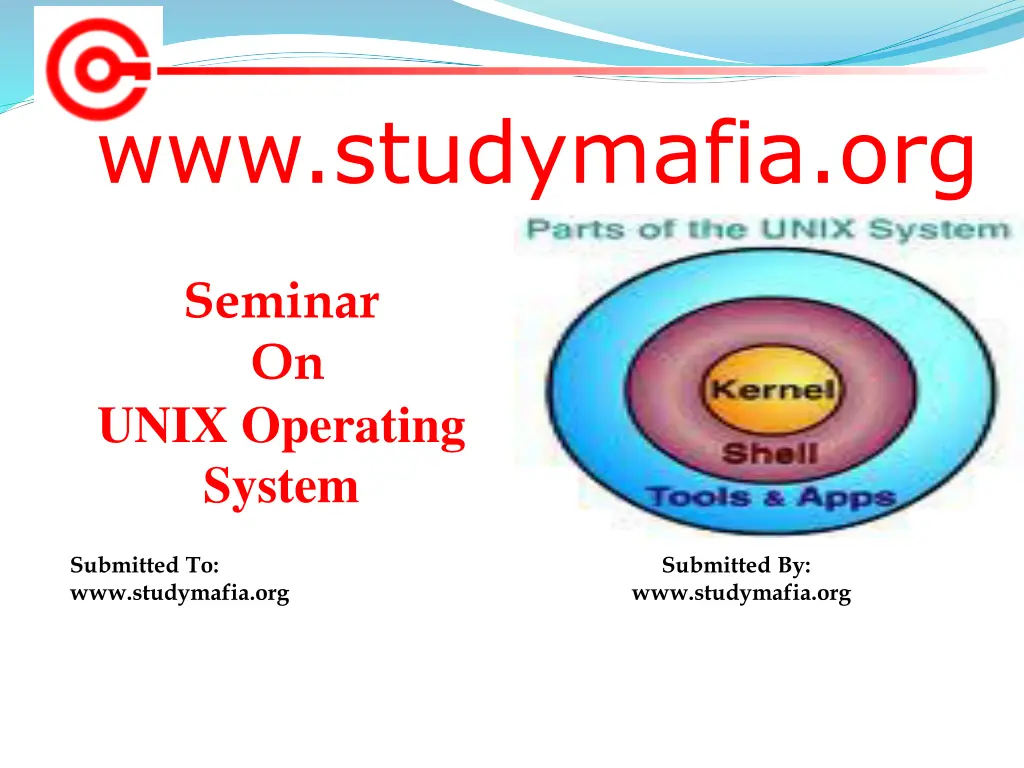
Understanding the History and Features of UNIX Operating System
"Explore the evolution and key aspects of the UNIX operating system, from its inception in the 1970s to its commercial developments in the 2000s. Learn about its unique features, commands, file system, memory management, and applications."
Download Presentation

Please find below an Image/Link to download the presentation.
The content on the website is provided AS IS for your information and personal use only. It may not be sold, licensed, or shared on other websites without obtaining consent from the author. If you encounter any issues during the download, it is possible that the publisher has removed the file from their server.
You are allowed to download the files provided on this website for personal or commercial use, subject to the condition that they are used lawfully. All files are the property of their respective owners.
The content on the website is provided AS IS for your information and personal use only. It may not be sold, licensed, or shared on other websites without obtaining consent from the author.
E N D
Presentation Transcript
www.studymafia.org unix-parts Seminar On UNIX Operating System Submitted To: www.studymafia.org www.studymafia.org Submitted By:
Contents 1. History of UNIX 2. What is UNIX 3. Commands 4. File System 5. Memory Management 6. Interrupts 7. Why Use UNIX? 8. Applications continued
(Brief) History 1970s In the 1970s Brian Kernighan coined the project name Unics as a play on Multics, (Multiplexed Information and Computing Service). Unics could eventually support multiple simultaneous users, and it was renamed Unix
(Brief) History 1980s AT&T licensed UNIX System III, based largely on Version 7, for commercial use, the first version launching in 1982. This also included support for the VAX. AT&T continued to issue licenses for older Unix versions. To end the confusion between all its differing internal versions, AT&T combined them into UNIX System V Release 1. This introduced a few features such as the vi editor and curses from the Berkeley Software Distribution of Unix developed at the University of California, Berkeley. This also included support for the Western Electric 3B series of machines.
(Brief) History 1990s In 1990, the Open Software Foundation released OSF/1, their standard Unix implementation, based on Mach and BSD. The Foundation was started in 1988 and was funded by several Unix-related companies that wished to counteract the collaboration of AT&T and Sun on SVR4. Subsequently, AT&T and another group of licensees formed the group "UNIX International" in order to counteract OSF. This escalation of conflict between competing vendors gave rise again to the phrase "Unix wars".
(Brief) History 2000s In 2000, SCO sold its entire UNIX business and assets to Caldera Systems, which later on changed its name to The SCO Group. The dot-com bubble (2001 2003) led to significant consolidation of versions of Unix. Of the many commercial variants of Unix that were born in the 1980s, only Solaris, HP- UX, and AIX were still doing relatively well in the market, though SGI's IRIX persisted for quite some time. Of these, Solaris had the largest market share in 2005
What is UNIX? The UNIX Operating System (OS) is a large program (mostly coded in C) that turns the computer into a useable machine. man_question_mark It provides a number of facilities: management of hardware resources directory and file system loading / execution / suspension of programs
terminal Commands Directory commands cd Change the working directory find Find a file by name or by other characteristics mkdir Make a directory rmdir Remove a directory File manipulation commandscat Concatenate and display a file cp Copy a file grep Search a file for a specific text string mv Move or rename a file rm Remove a file
terminal Commands Display commands date Print the date and time ls List the contents of a directory pwd Display the working directory pathname tail Display the end of a file Process commands exit Terminate a process kill Terminate or send a signal to a process passwd Create or change a password ps Display the status of a process telnet Connect to a remote system using the Telnet protocol
The UNIX File System 1. An upside-down Tree 2. Some System Directories 3. Pathnames 4 Commands and Pathnames
1.An upside-down Tree A simplified UNIX directory/file system: / etc . . . bin export dev . . . tmp . . . date user . . . cal home ad . . . . . . . s3910120 exam.txt proj1 . . . work . . . hobby.c
2.Some System Directories / root directory /bin commands /etc system data files (e.g. /etc/passwd) /dev files representing I/O devices
3.Pathnames A pathname is a sequence of directory names (separated by / s) which identifies the location of a directory. There are two sorts of pathnames absolute pathnames relative pathname
3.1Absolute Pathnames The sequence of directory names between the top of the tree (the root) and the directory of interest. For example: /bin /etc/terminfo /export/user/home/ad /export/user/home/s3910120/proj1
3.2Relative Pathnames The sequence of directory names below the directory where you are now to the directory of interest. If you are interested in the directory proj1: proj1 s3910120/proj1 home/s3910120/proj1 if you are in s3910120 if you are in home if you are in user
4.Commands and Pathnames Commands often use pathnames. For example: /usr/games/fortune cat /etc/passwd List the password file
Memory Management Memory *Primary memory is a precious resource that frequently cannot contain all active processes in the system *The memory management system decides which processes should reside (at least partially) in main memory *It monitors the amount of available primary memory and may periodically write processes to a secondary device called the swap device to provide more space in primary memory *At a later time, the kernel reads the data from swap device back to main memory
Memory Management UNIX Memory Management Policies Swapping Easy to implement Less system overhead Demand Paging Greater flexibility
Memory Management Swapping The swap device is a block device in a configurable section of a disk Kernel allocates contiguous space on the swap device without fragmentation It maintains free space of the swap device in an in-core table, called map The kernel treats each unit of the swap map as group of disk blocks As kernel allocates and frees resources, it updates the map accordingly
Memory Management Demand Paging Not all page of process resides in memory Locality When a process accesses a page that is not part of its working set, it incurs a page fault. The kernel suspends the execution of the process until it reads the page into memory and makes it accessible to the process
See original image Interrupts Interrupt When a process terminates abnormally it usually tries to send a signal indicating what went wrong. C programs (and UNIX) can trap these for diagnostics. Also user specified communication can take place in this way.
See original image Interrupts Signals are software generated interrupts that are sent to a process when a event happens. Each signal has a default action which is one of the following: 1 The signal is discarded after being received 2 The process is terminated after the signal is received 3 A core file is written, then the process is terminated 4 Stop the process after the signal is received
See original image Interrupts Each signal defined by the system falls into one of five classes: 1 Hardware conditions 2 Software conditions 3 Input/output notification 4 Process control 5 Resource control
Why Use UNIX? multi-tasking / multi-user lots of software networking capability graphical (with command line) easy to program portable (PCs, mainframes, super-computers) continued
Applications Storage Consultancy Expert advice on all forms of storage technologies. Storage management software. Solutions that can grow and evolve as your business does. Experienced fully trained and accredited consultants. Independent recommendations on storage technologies. Full project management to implement storage technologies.
Applications Backup & Recovery Consulting Identify inefficiencies with your current backup and recovery environment that may be costing you time and money. Ensure your backup and recovery architecture meets your changing production environment and SLAs. Configure and optimize all aspects of your backup and recovery environment.
Applications Middleware & Database Administration Installation and configuration of WebLogic and Websphere application servers in highly available clustering environment. Understanding the complexities of infrastructure design and maintenance, analyze architecture and security issues Hardening productions environments. Assisting clients in aspects of deploying J2EE applications and connecting to back end resources. Providing development and production environments. Finding performance bottlenecks and tuning of existing Websphere or WebLogic applications servers.
References www.google.com www.wikipedia.com www.studymafia.org

